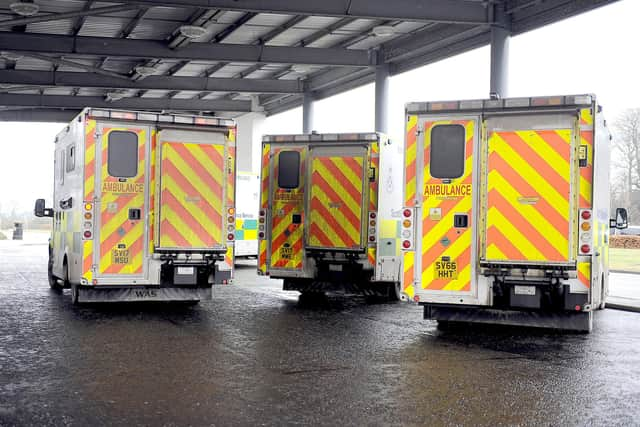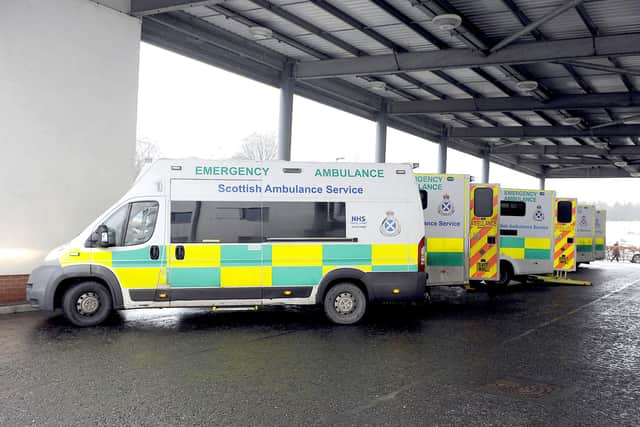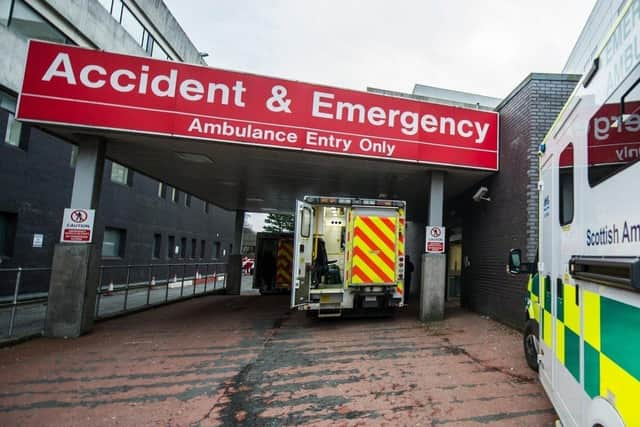NHS Scotland winter crisis: Critically-ill Scots face waits of more than four hours in back of ambulances outside A&Es
Some patients spent over four hours waiting in ambulances outside Scottish accident-and-emergency (A&E) departments over New Year, new figures have revealed, as NHS Scotland struggles to cope with the latest winter crisis.
In the week commencing January 1, one in ten ambulances transporting patients to University Hospital Crosshouse in Kilmarnock spent more than four hours and 25 minutes waiting outside, according to Scottish Ambulance Service (SAS) figures.
Advertisement
Hide AdAdvertisement
Hide AdIn Lanarkshire, around 30 of the 315 ambulances dispatched to transport patients to University Hospital Wishaw were forced to wait more than four hours and 38 minutes outside the emergency department.


Furthermore, one in ten ambulances arriving at Aberdeen Royal Infirmary or the Queen Elizabeth University Hospital (QEUH) in Glasgow spent more than three hours outside emergency rooms with patients.
It comes just days after the Royal College of Emergency Medicine warned Scotland’s A&Es have experienced “a total collapse” over the festive season, with waits of over 80 hours being experienced, tens of ambulances “stacked up” outside emergency departments and excess deaths skyrocketing.
A spokesperson for the College of Paramedics said the body was “very concerned” this winter would be “another extremely difficult one for patients and our members”.
“Increase in hospital handover delays risks patient harm, leading to an inability to reach patients in the community,” the spokesperson said.


“Delays in patients moving on from emergency departments causes a delay to patients being handed over from ambulances, which causes delays in 999 responses. When ambulances are delayed in attending, understandably, members of the public call 999 again when something gets worse with the patient’s condition, or when the ambulance does not arrive in the timeframe they expected. It is these ‘call backs’ which result in increased numbers of 999 calls and therefore challenges in answering them.
“Whilst continued support and investment in ambulance services and the paramedic profession are desperately required, the College of Paramedics calls on the [Scottish] Government and the First Minister to urgently address issues within emergency departments where every day the valuable and precious capacity of paramedics is lost when waiting to handover patients.
“Moreover, we are of the firm opinion that greater investment is needed to ensure that community services with multi-disciplinary teams are robust and fit for purpose, and that social care is able to cope with the inevitable demands placed on it during particularly challenging periods.”
Advertisement
Hide AdAdvertisement
Hide AdDuring the week starting January 1, the SAS conveyed 7,382 incidents to Scottish A&Es. On average, ambulances had to wait 48 minutes outside emergency departments, with 10 per cent of ambulances overall spending over two hours sat waiting outside A&Es with patients.


According to Public Health Scotland, just 60.8 per cent of people who attended A&E in the week to December 31 were seen within the target time – a fall from 65 per cent the previous week.
However, NHS Scotland professionals are warning the following week’s A&E statistics – from January 1 to January 7 – are set to be even worse when they are published on Tuesday. The number of people waiting more than 12 hours during the week to December 31 also rose by almost a third, from 964 to 1,271, while the number waiting longer than eight hours rose from 2,584 to 3,178.
The Royal College of Emergency Medicine (RCEM) has calculated there will be an excess death for every one in 72 patients who spend between eight and 12 hours in an emergency department. The RCEM estimates that in 2023, 1,635 Scots died needlessly due to A&E pressures, with 50 excess deaths being recorded a week during the worst winter pressures.
Scottish Conservative shadow health secretary, Dr Sandesh Gulhane, said ambulances queuing outside hospitals and “unacceptable” turnover times of more than four hours were “unfortunately a grim foretaste of the pressures our NHS faces this winter”.
“Thanks to the SNP’s mismanagement and dire workforce planning, the impact on A&E departments and my already overstretched colleagues across the NHS will only get worse,” he said. “We need urgent action, but there is no sign of the dithering and discredited [health secretary] Michael Matheson doing anything to tackle this crisis.”
Scottish Labour health spokesperson, Dame Jackie Baillie, said the rise in the number of “seriously long” ambulance turn-around times was “deeply worrying”.
“We know that the quicker ambulance crews can discharge patients into the care of hospital staff, the quicker that they can get back on the road and respond to other calls,” she said. “With A&E waits soaring and staff under serious pressure, we cannot allow the SNP government to take its eye off the ball on this serious issue.
Advertisement
Hide AdAdvertisement
Hide Ad“It’s time for the embattled Michael Matheson to focus on the day job and get to grips with this issue.”
A Scottish Government spokesperson said: “The heightened winter pressure being felt by our A&Es is not unique to Scotland, with similar challenges being felt by emergency departments throughout the UK. We absolutely recognise that the system remains under pressure, and waiting times are longer than we want them to be for some patients.
“Health boards are seeing delayed discharges continue to drive up A&E waits, which is why we are working with them to ensure people who do not need to be in hospital leave without delay, freeing up vital beds for those who need them most.
“We are clear that there should be no unnecessary delays for ambulance crews handing over patients at hospitals. NHS staff are working hard to ensure quick and safe handover of patients, releasing ambulance crews back into the community.”
Comments
Want to join the conversation? Please or to comment on this article.